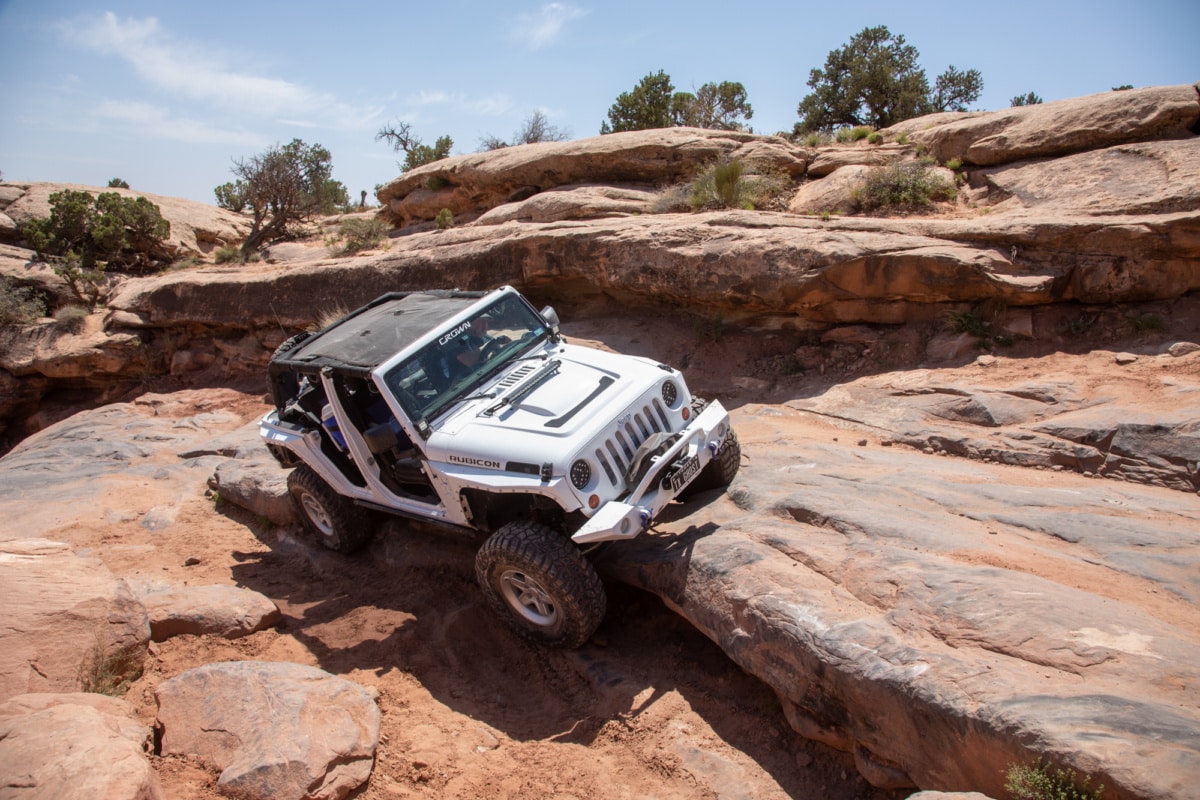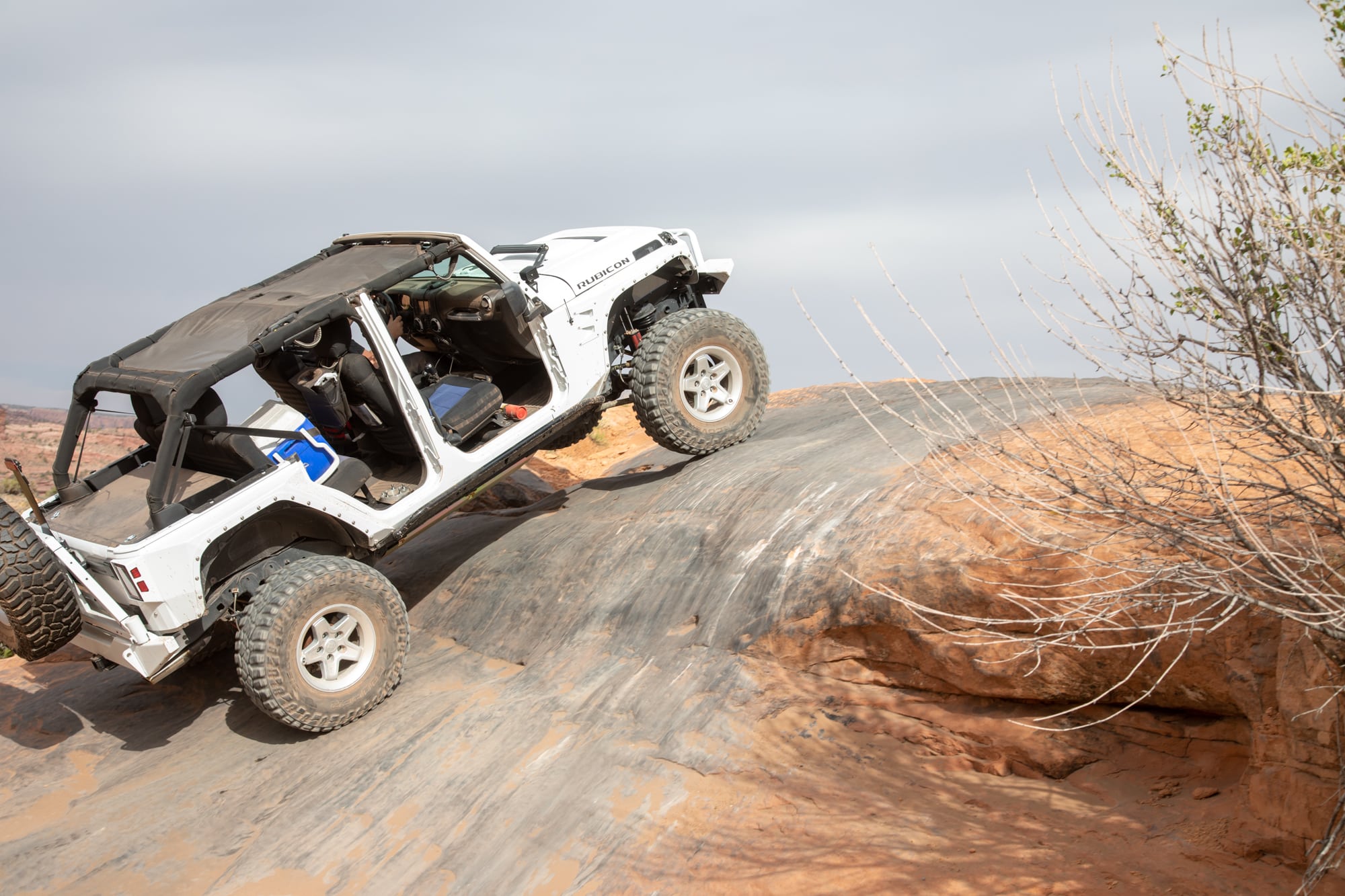
(photo credit: Craig Carlson)
I'd conquered worse. It really shouldn't have been a big deal.
And yet, here we were.
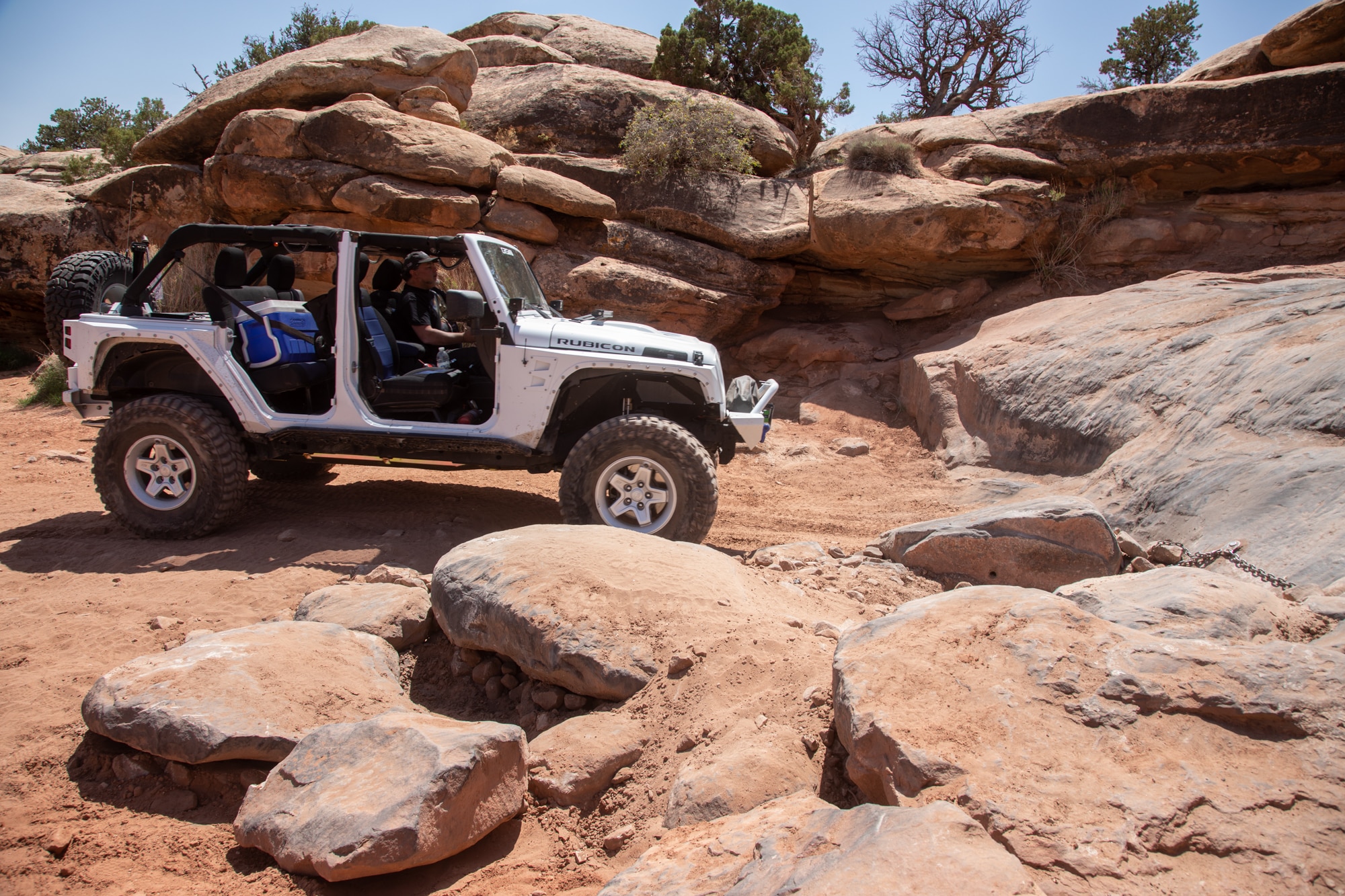
On approach to the Waterfall obstacle (photo credit: Craig Carlson)
It's called "The Waterfall," a multi-staged ascent on a trail called Gold Bar Rim, which is a part of the Golden Spike trail. It was a couple hours after the spacers broke on the trail, amputating my driver's side wheel.
The early-morning mishap had done a number on my nerves, but I was starting to gain more confidence. I had done this type of thing before.
I've been going on the Geeks with Jeeps trip to Moab ever since 2015, and with the exception of being very ill one year and 2020 when the entire town was shut down for Covid, I've been an active participant in every trail ride.
Note that I said, "participant." For many years I've acted more as a photographer than as a driver, even though I've driven quite a few times with a rental or being allowed to drive friends' jeeps.
Ghost, my Jeep, is a very capable vehicle. I bought it off an auction site - Bring a Trailer - where the previous owner(s) had made significant upgrades and improvements. Upgraded axles. Top-end suspension. Body armor. Upgraded bumpers. And so on.
I'd made quite a few additions myself. I installed heavy-duty skid plates (Metalcloak, for those in-the-know), relocated the evap canister, relocated the mirrors to off-road positions, and a few additional cosmetic and functional upgrades.
Yet, you can have the best Jeep in the world and it won't do you any good if you don't know how to drive it. When you drive off-road, there are some counter-intuitive aspects to keep in mind. In some cases, you want to do the exact opposite of what you'd do on the road.
For instance, sometimes you want the tires to go over boulders (as opposed to steering away from them) so that they won't destroy your axles or differentials. Sometimes you want to hit the gas on a descent in order to pull the rear of the Jeep towards the ground, as opposed to flipping the rear end over your head.
That sort of thing.
That's the kind of thing that you learn through practice and experience. I'd had some of that over the years, but it hadn't been consistent. In fact, there were some years when I didn't drive at all. So, while I'd had exposure to things like this before, there were major issues for me to overcome.
I knew that this year was going to push my capabilities - and Ghost's. This year it was just Dave's Jeep and mine, so we weren't restricted by the limited trail selection that the rental companies imposed on us. He's been hampered by those restrictions whenever we caravanned through the trails, and I was looking forward to seeing new scenery as well.
Even so, I'm still getting used to Ghost. Most of the time, the Jeep surprised me (in a good way). It made quick work of many of the obstacles that looked absolutely brutal.
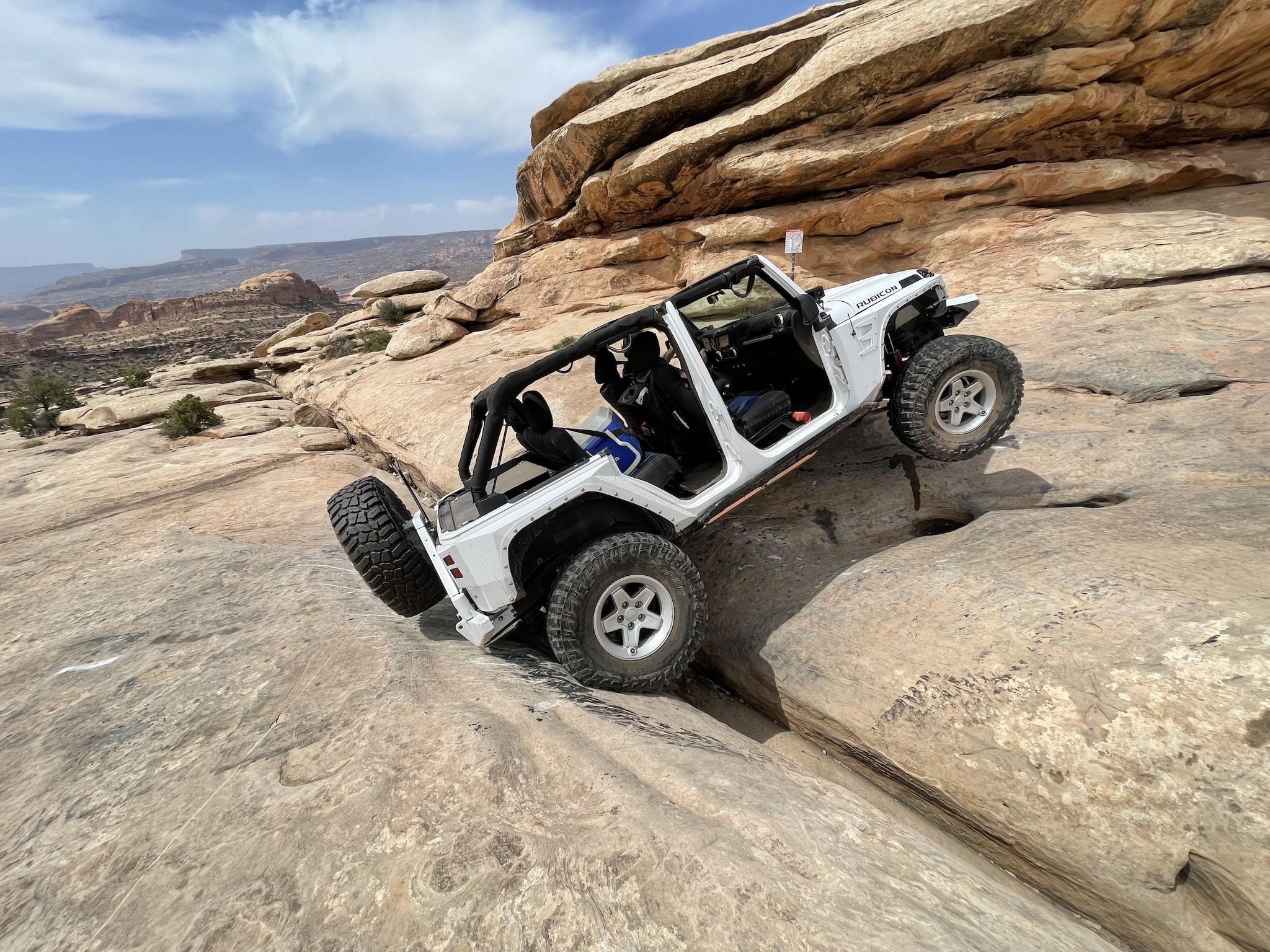
Some obstacles looked tougher than they were (photo credit: Craig Carlson)
As I look back at the start of the Moab trip, I now realize that I had less than 30 hours of butt-in-driver's seat with Ghost, and less than five hours of off-roading experience with it.
I've had more time and experience preparing Ghost than driving it. As a result, I was still trying to get used to all the changes made to the Jeep - and there were a lot of them.
One of the modifications that were made by previous owners included relocating the air lockers to the A pillar and disconnecting the buttons from the dash. For that reason, I was convinced that all the buttons on the dash were disabled.
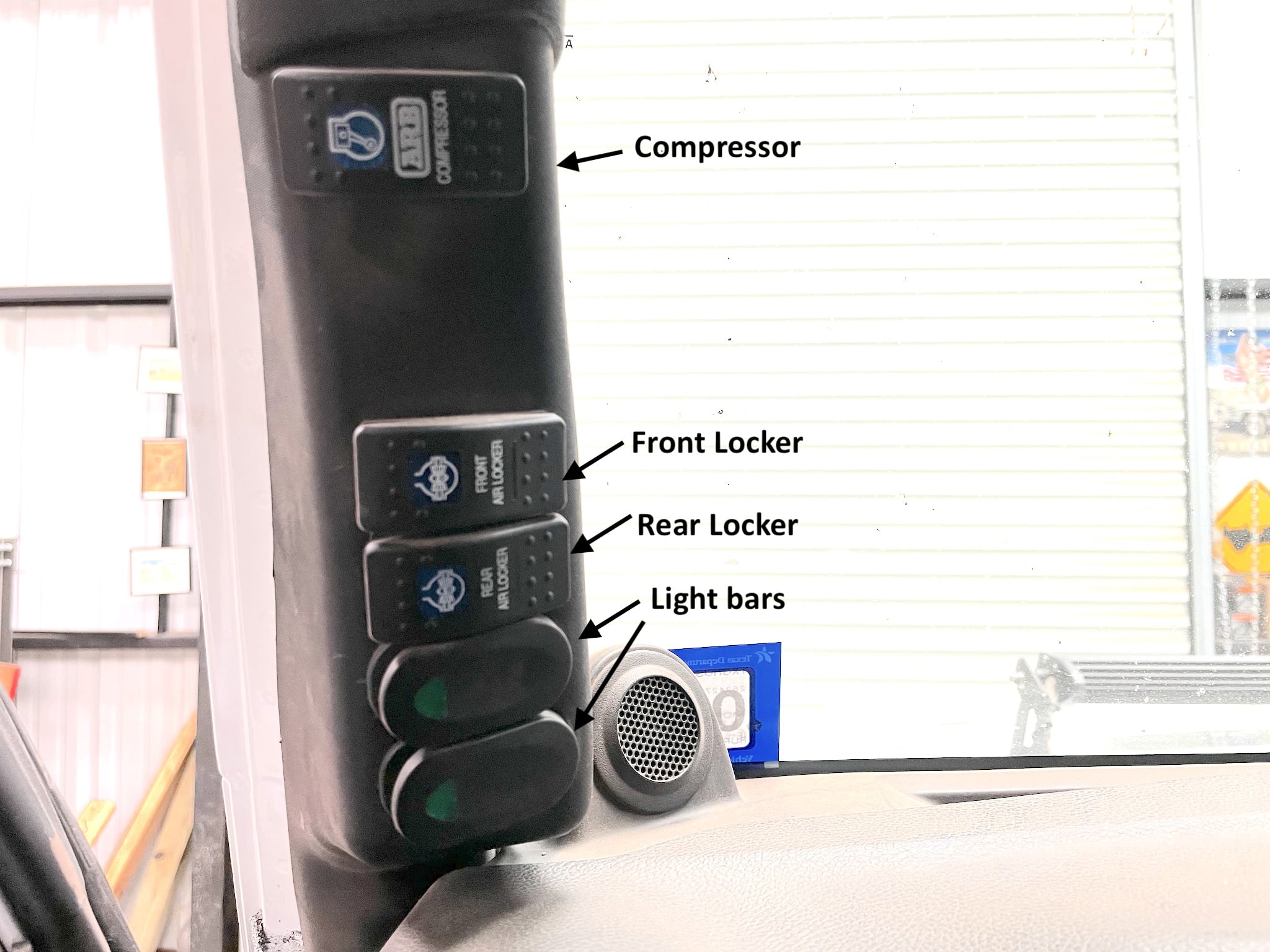

I was wrong.
Look, I can make all the excuses in the world for why things went wrong, but at the end of the day I simply didn't know my Jeep as well as I thought I did (or should have). I paid a very high price for it.
And nearly paid a much higher price.
For those who don't off-road, there are a couple of technical devices that significantly help you get over those really big obstacles.
First, there are things called lockers. Their function is to lock the differentials so that both of the wheels are sent power equally. Without them, you could have a situation where a tire hangs in the air while the other tire sits still. It's much better to have power going to both wheels in case this happens (and it happens a lot).
With the locker and compressor controls relocated to the A pillar, I had no problem remembering to use them. So... "yay."
Second, for off-roading you want to disconnect the sway bar. A sway bar is designed to keep the reduce articulation and keep the wheels as level as possible. So, when you need to have tires on the ground as much as possible - which can mean pretty radical articulation - you want to disconnect it.
No lie, I didn't know how to disconnect the sway bar on Ghost. Remember, I honestly thought that the entire button panel which included the sway bar button had been disconnected when the axle lock controls were relocated. I thought they had simply been lazy and not removed the existing buttons.
So, for the first three days of running Moab. through Steel Bender, Golden Spike, and Strike Ravine - the sway bar remained connected. And it caused all kinds of problems. I wouldn't even know how many issues it caused me until the end of the week (more on that in the next post).
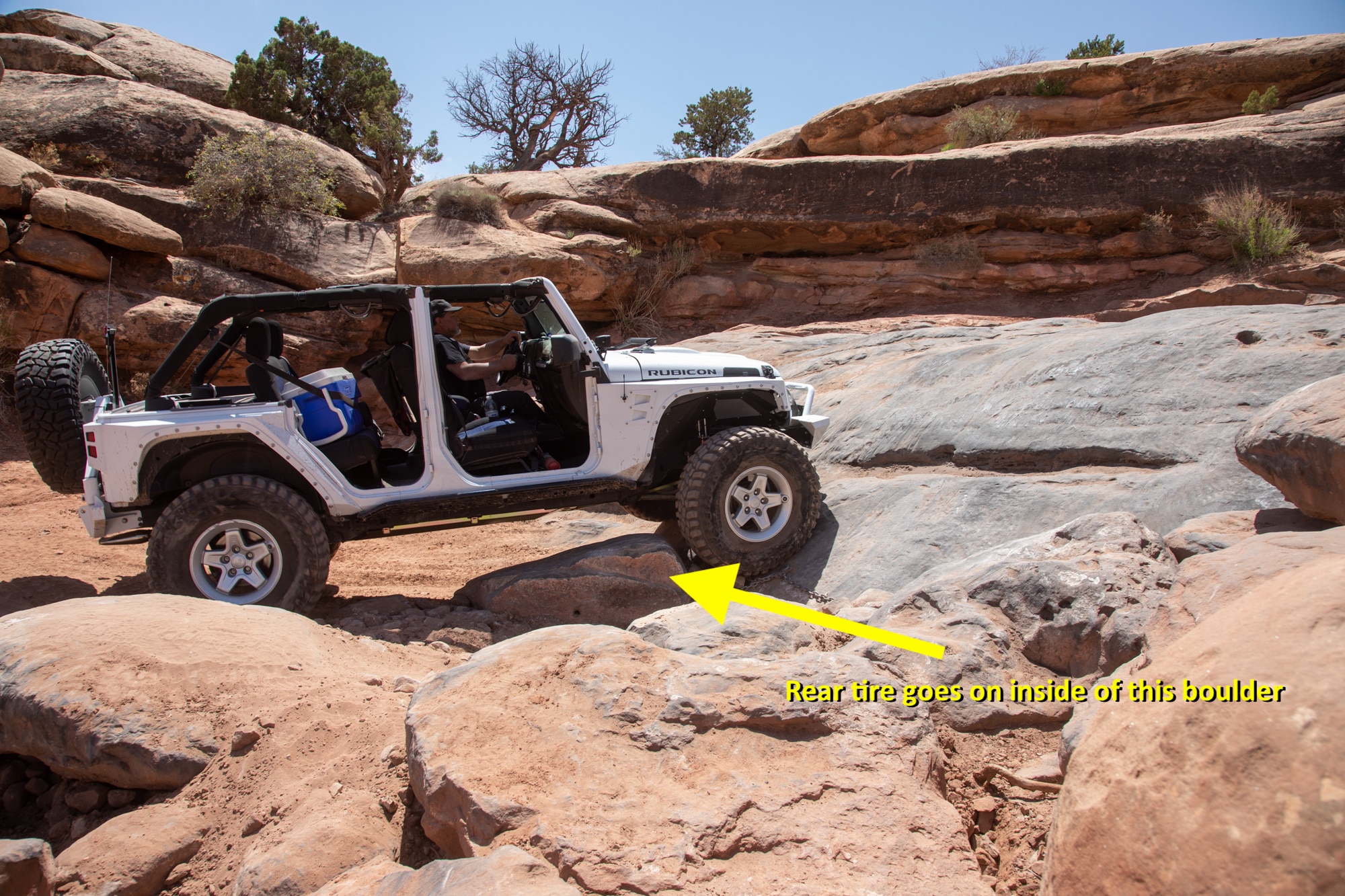
Needed to aim for the inside of the boulder (photo credit: Craig Carlson)
For the waterfall, I found myself puzzled as I struggled to get over the obstacle that I was convinced Ghost could take.
In my head, I visualized the line that I needed to take, committed to it, and honestly believed that all four tires were going to be on the ground going up.

Note the location of the rear tire on the outside of the boulder (photo credit: Craig Carlson)
If you look at the photo above, you'll see that the front axle is in a straight line. That's a result of the sway bar still engaged. The passenger front tire should have remained on the rocks to help pull Ghost up and over.
From my angle in the driver's seat, I couldn't see it. Instead, I was feeling Ghost slip to the right. So, I wasn't thinking about the sway bar situation, and neither were my driving companions. They likely assumed that the sway bar was disconnected - because why wouldn't it be!?
I had aimed for the inside of the boulder, but overestimated my approach and the rear tire slipped and fell off to the right. With the front tire hanging in the air, there was nothing on the passenger side to counteract the force of gravity.
The boulder shifted, the rear tire moved laterally fast. The axle slammed to the moving boulder and jolted the underside of the Jeep with an atrocious bang!
I don't know about you, but when vehicles go sideways (and you're not intending to drift), I don't like it. Not one little bit, Sam-I-Am.
Pushing Ghost up the hill became nerve-wracking. No matter what I did, I couldn't get Ghost to go up and over that mound. It started to bounce.
Bouncing is bad.
When you bounce, you break things.
It took four or five tries to get Ghost up and over the obstacle that should have taken only one. At the top of that first hill (out of several obstacles), I stopped and got my breath.
I thought I was out of the woods, so I started driving towards the next one.
In horror, I instantly knew I had made a grave mistake.
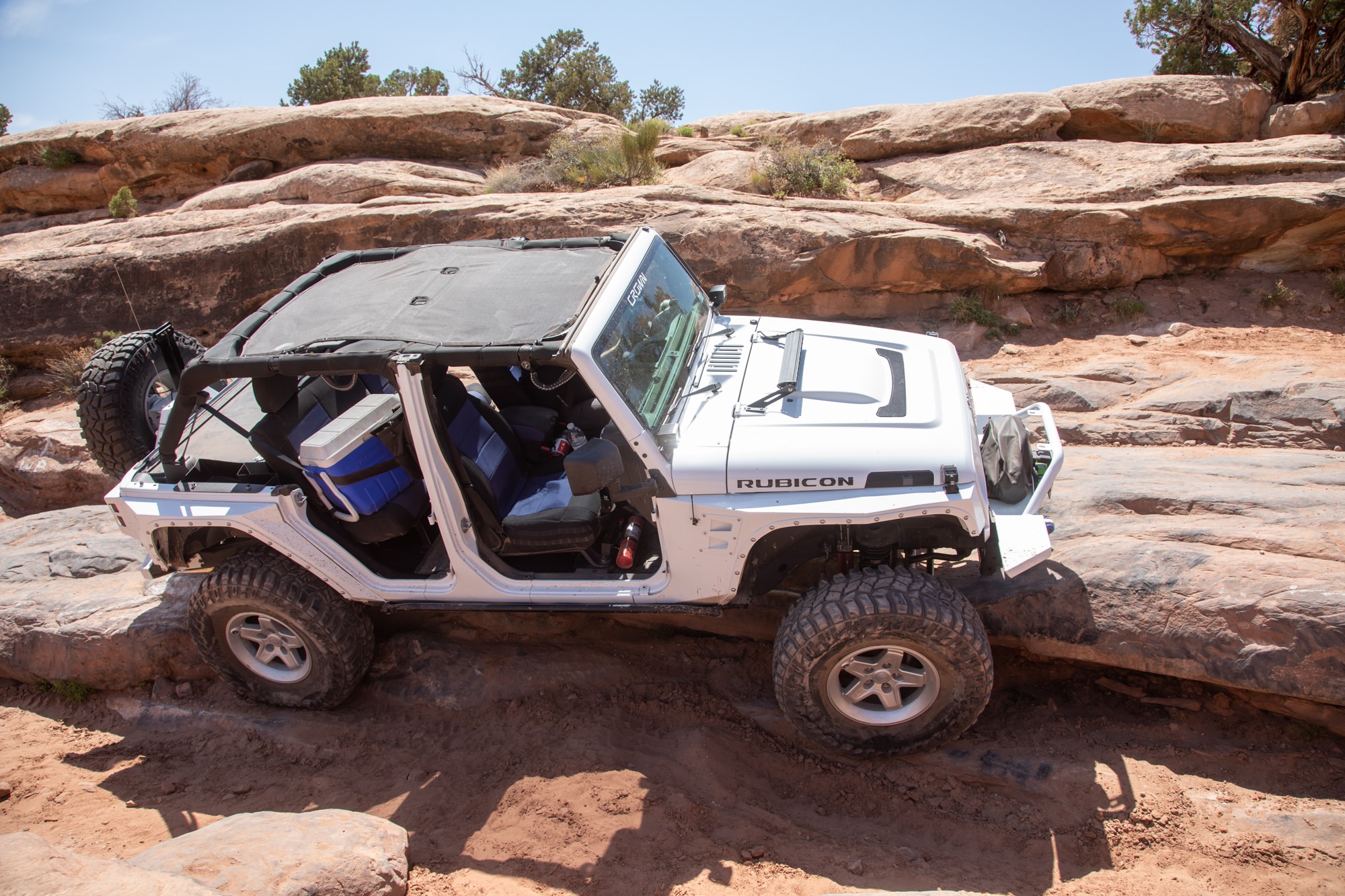
At serious risk of sliding off and tipping onto its side (photo credit: Craig Carlson)
This wasn't a case of celebrating too early, but rather not actually seeing the ledge from my vantage point in the driver's seat.
Getting up the hill had meant pressing close to the rock face on the driver's side, which meant that the ledge at the passenger's side was beyond my field of view.
I realized my mistake almost immediately, as Ghost started to slide - hard - to the right.
Instinctively, I slammed on the brakes, but Ghost kept sliding to the right and forward, the passenger side dipping further and further downward. I could see beyond the nose, and knew that there wasn't much ground to cover before slamming into giant boulders or through an opening and over the crest.
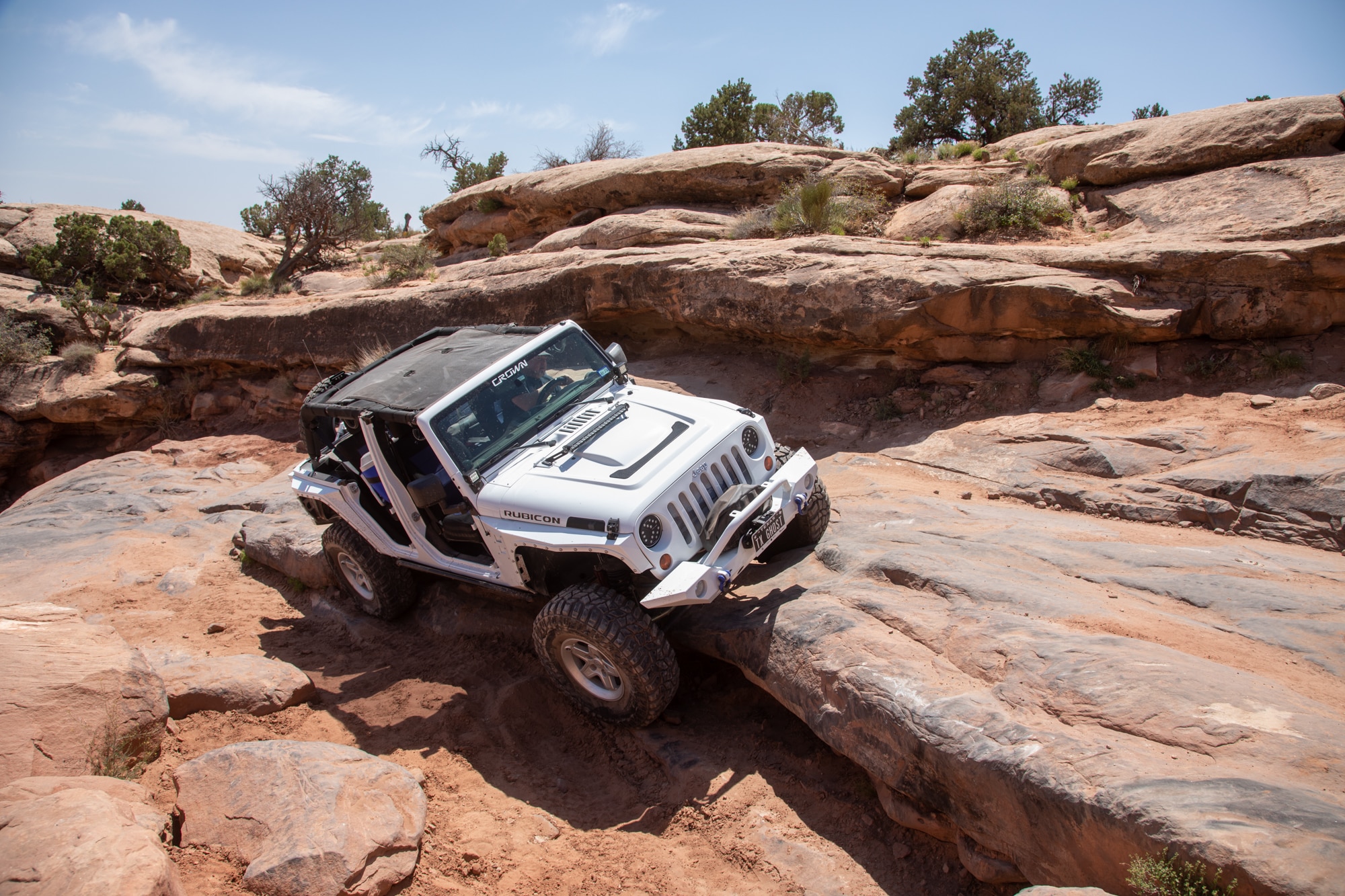
It gets worse. Much, much worse. (photo credit: Craig Carlson)
When Ghost finally came to rest, my entire body was holding the steering wheel locked in place. It felt like breathing too hard would send me careening to the right.
I was truly, genuinely stuck.
Whenever I put Ghost into reverse, it would slide further to the right. In the photo above, I was holding on to the steering wheel with every ounce of pressure I could muster.
After this photo was taken (the last photo before it was all hands on deck and no one could take pictures), Ghost slipped even further.
The passenger side door showed only dirt. And it was very close.
Outside the windshield, I saw the hill that I would roll down if I went any further. At that moment, I became the Texas Ghost!
Dave came back down with his Jeep. "How did you do that? he asked. "Why did you do that?"
"Trying to be creative?" I tried to joke, but I wasn't feeling it.
Dave took a look at the passenger side and how close I was to massive boulders. He was convinced that I wasn't going to be able to get Ghost out without some very expensive damage.
He hooked his winch up to my D-rings on my front bumper. Craig (who had been my passenger and who was taking all of these photos) got into Dave's jeep and stood on the brakes.
The stress of the winch trying to keep Ghost steady nearly pulled Dave's Jeep toward the edge as well, even with Craig practically standing on the brakes.
Under Dave's guidance, I tried to get the steering in such a way that the wheels were dead-on to the ledge. As you can see from the photo above, that was nearly an impossible task.
I got no help from the power steering. I was struggling to get the wheels to turn even a fraction of an inch, and every time I did Ghost would slip even more.
There were numerous times when both tires on the driver's side were up in the air and Ghost rocked to its tipping point.
I was sweating. Panting. I locked my arms against my sides to give me extra leverage to keep the steering wheel pointed in the right direction. My shoulders ached, my hands were falling asleep. Pins and needles made me long to shake them to get some relief.
Ghost slipped again, this time violently and the rear swung out towards the right - right towards the edge of the hill.
The hill was only about twenty-five or thirty feet down, but it was all boulders and rocks and cactus. I mentally prepared myself for the possibility of rolling over onto the roof or the side. I'd give up on the steering wheel, I thought, and tuck my arms into my chest and rag doll my body so that the impact wouldn't kill me.
So I hoped.
"Well," Dave said thoughtfully, catching his breath. The sudden movement had startled him as well. "Actually, you're in a better position now."
I looked out at the driver's tire, which was now much more perpendicular to the ledge. Sure enough, for the first time in about a half hour, this seemed doable.
Even so, there wasn't much room. At the angle that I was pointing, I still needed to be very careful.
And yet, every time I even breathed on the gas pedal, the supercharger would kick in. The familiar whine would race the engine and Ghost would try to shoot up over the ledge. Worse, every time it felt like I was making progress, the driver's side tire would rise into the air off the ledge, spinning madly.
At one point in time, the tire itself was at a higher elevation than my head. I was actually looking up at it.
"Not so much!" Dave scolded me, but I had barely touched the accelerator. There are times when a supercharger may not be your friend.
Slowly, as carefully as I could, we got the tires facing the ledge more or less due on. Eventually, after much trial and error, Ghost was able to 'walk' to a point on the ledge where both tires were able to get a good grip and pull the Jeep up and over.
Once on level ground, I stopped and gave myself a moment to calm down. The adrenaline that was going through me could have killed a race horse. I was too scared to be grateful and relieved, though that would come eventually.
It wasn't until the end of the next day that Craig would ask about the sway bar, and I told him what I thought was the reality - that the buttons on the dash were inoperative as they had moved them to the A pillar (except there was no sway bar button on the A pillar - just lockers).
Dave, though, told me that I was wrong and nonchalantly hit the sway bar disconnect button... which lit up instantaneously.
You ever have one of those forehead-slapping moments where you can't believe how stupid you were? For not even trying the button?
Yeah, I'm still having that moment. It's humiliating.
All in all, by not disconnecting the sway bar I not only made the ride much rougher than it needed to be, more dangerous than it needed to be, and more difficult than it needed to be, I'm convinced that I put considerable stresses on Ghost that it didn't need.
Three days later, on the most difficult trail any of us have ever encountered, all of those errors were going to come back and bite me on the ass.

